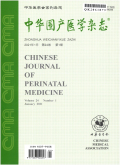孕妇外周血胎儿游离DNA无创产前检测在颈项透明层增厚胎儿中的应用效能
Efficacy of non-invasive prenatal testing of fetal free DNA in maternal peripheral blood in fetuses with increased nuchal translucency
摘要目的:探讨孕妇外周血胎儿游离DNA无创产前检测(non-invasive prenatal testing,NIPT)在颈项透明层(nuchal translucency,NT)增厚胎儿中应用的效能。方法:回顾性纳入2014年6月至2022年12月因胎儿NT增厚(≥3.0 mm)于南京大学医学院附属鼓楼医院行染色体微阵列分析(chromosomal microarray analysis,CMA)的单胎妊娠孕妇1 184例。根据胎儿NT增厚是否合并其他高危因素分为:孤立性NT增厚且非高龄(再分为3.0 mm≤NT<3.5 mm、3.5 mm≤NT<4.0 mm和NT≥4.0 mm亚组)、孤立性NT增厚且高龄、NT增厚合并鼻骨发育异常、NT增厚合并其他软指标以及NT增厚合并结构异常组。假设本中心NIPT和扩展性NIPT的灵敏度和特异度均为100%,将NIPT和扩展性NIPT检测范围以外的其他基因组异常称为NIPT残余风险和扩展性NIPT残余风险。采用 χ2检验和Bonferroni校正,比较孤立性NT增厚且非高龄组中3个亚组之间NIPT和扩展性NIPT的残余风险。 结果:(1)孤立性NT增厚且非高龄组中,3.0 mm≤NT<3.5 mm亚组329例,CMA检出异常19例[染色体非整倍体12例、致病性拷贝数变异(pathogenic copy number variation,pCNV)7例],NIPT和扩展性NIPT残余风险均为2.1%(7/329);3.5 mm≤NT<4.0 mm亚组173例,CMA检出异常29例(染色体非整倍体17例、pCNV 9例、染色体不平衡易位3例),NIPT残余风险为8.1%(14/173),扩展性NIPT残余风险为7.5%(13/173);NT≥4.0 mm亚组270例,CMA检出异常70例(染色体非整倍体50例、pCNV 16例、不平衡易位3例、性染色体异常合并pCNV 1例),NIPT残余风险为12.2%(33/270),扩展性NIPT残余风险为7.0%(19/270)。3.0 mm≤NT<3.5 mm亚组NIPT和扩展性NIPT残余风险均低于3.5 mm≤NT<4.0 mm和NT≥4.0 mm亚组(Bonferroni校正, P值均<0.017)。(2)孤立性NT增厚且高龄组92例,CMA检出异常36例(染色体非整倍体29例、pCNV 5例、21-三体合并性染色体异常1例、18-三体合并性染色体异常1例),NIPT残余风险为7.6%(7/92),扩展性NIPT残余风险为5.4%(5/92)。(3)NT增厚合并鼻骨发育异常组49例,CMA检出异常24例(染色体非整倍体23例、pCNV 1例),NIPT及扩展性NIPT残余风险均为2.0%(1/49)。(4)NT增厚合并其他软指标组26例,CMA检出异常9例(染色体非整倍体6例、pCNV 1例、染色体不平衡易位2例),NIPT及扩展性NIPT残余风险均为11.5%(3/26)。(5)NT增厚合并结构异常组245例,CMA检出异常121例(染色体非整倍体107例、pCNV 7例、染色体不平衡易位4例、21-三体合并20-三体1例、18-三体合并性染色体异常2例),NIPT残余风险为16.7%(41/245),扩展性NIPT残余风险为4.1%(10/245)。 结论:孤立性NT≥3.5 mm或NT≥3.0 mm但合并其他高危因素者,可建议孕早期行绒毛穿刺产前诊断,将产前诊断的时机由孕中期前移至孕早期。孤立性3.0 mm≤NT<3.5 mm的胎儿即使NIPT低风险,仍需在咨询中充分告知胎儿染色体异常的残余风险为2.1%。
更多相关知识
abstractsObjective:To explore the efficacy of non-invasive prenatal testing (NIPT) of fetal free DNA in maternal peripheral blood in fetuses with increased nuchal translucency (NT).Methods:A retrospective analysis was conducted on 1 184 singleton pregnant women that underwent chromosomal microarray analysis (CMA) at Nanjing Drum Tower Hospital, Nanjing University Medical School from June 2014 to December 2022 due to fetal increased NT (≥3.0 mm). These subjects were categorized based on whether the increased NT was accompanied by other high-risk factors into isolated increased NT without advanced maternal age (further subdivided into 3.0 mm≤NT<3.5 mm, 3.5 mm≤NT<4.0 mm, and NT≥4.0 mm subgroups), isolated increased NT with advanced maternal age, increased NT with nasal bone abnormalities, increased NT with other soft markers, and increased NT with structural abnormalities groups. Assuming the sensitivity and specificity of NIPT and expanded NIPT at this center were both 100%, genomic abnormalities outside the detection range of NIPT or expanded NIPT were termed as residual risk of NIPT or expanded NIPT. Chi-square test and Bonferroni correction were used to compare the residual risks of NIPT and expanded NIPT among the three subgroups of isolated increased NT without advanced maternal age group. Results:(1) In the group of isolated increased NT without advanced maternal age: For the 3.0 mm≤NT<3.5 mm subgroup (329 cases), 19 abnormalities were detected by CMA [12 cases of chromosome aneuploidy, seven cases of pathogenic copy number variation (pCNV)], with residual risks of NIPT and expanded NIPT both at 2.1% (7/329). For the 3.5 mm≤NT<4.0 mm subgroup (173 cases), 29 abnormalities were detected by CMA (17 cases of chromosome aneuploidy, nine cases of pCNV, three cases of chromosome unbalanced translocation), with residual risks of NIPT at 8.1% (14/173) and expanded NIPT at 7.5% (13/173). For the NT≥4.0 mm subgroup (270 cases), CMA detected abnormalities in 70 cases (50 cases of chromosome aneuploidy, 16 cases of pCNV, three cases of unbalanced translocations, and one case of sex chromosome abnormality combined with pCNV). The residual risk of NIPT was 12.2% (33/270), and the residual risk of expanded NIPT was 7.0% (19/270). The residual risks of NIPT and expanded NIPT in the 3.0 mm≤NT<3.5 mm subgroup were lower than those in the 3.5 mm≤NT<4.0 mm and NT≥4.0 mm subgroups (Bonferroni correction, all P<0.017). (2) In the group of 92 cases with isolated increased NT and advanced maternal age, CMA detected abnormalities in 36 cases (29 cases of chromosome aneuploidy, five cases of pCNV, one case of trisomy 21 combined with sex chromosome abnormality, and one case of trisomy 18 combined with sex chromosome abnormality). The residual risk of NIPT was 7.6% (7/92), and that of expanded NIPT was 5.4% (5/92). (3) In the group of 49 cases with increased NT combined with nasal bone abnormalities, CMA detected abnormalities in 24 cases (23 cases of chromosome aneuploidy and one case of pCNV). The residual risks of NIPT and expanded NIPT were both 2.0% (1/49). (4) In the group of 26 cases with increased NT combined with other soft markers, CMA detected abnormalities in nine cases (six cases of chromosome aneuploidy, one case of pCNV, and two cases of chromosome unbalanced translocations). The residual risks of NIPT and expanded NIPT were both 11.5% (3/26). (5) In the group of 245 cases with increased NT combined with structural abnormalities, CMA detected abnormalities in 121 cases (107 cases of chromosome aneuploidy, seven cases of pCNV, four cases of chromosome unbalanced translocations, one case of trisomy 21 combined with trisomy 20, and two cases of trisomy 18 combined with sex chromosome abnormalities). The residual risk of NIPT was 16.7% (41/245), and that of expanded NIPT was 4.1% (10/245). Conclusions:For isolated NT≥3.5 mm or NT≥3.0 mm combined with other high-risk factors, chorionic villus sampling in early pregnancy can be recommended, advancing the timing of prenatal diagnosis from the second trimester to the first trimester. For fetuses with isolated 3.0 mm≤NT<3.5 mm, the 2.1% residual risk of chromosomal abnormalities should be fully informed during counseling, even if the risk of NIPT is low.
More相关知识
- 浏览2
- 被引0
- 下载0


相似文献
- 中文期刊
- 外文期刊
- 学位论文
- 会议论文



 换一批
换一批 换一批
换一批



